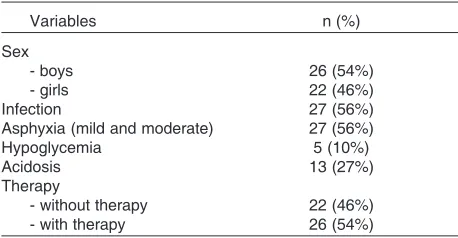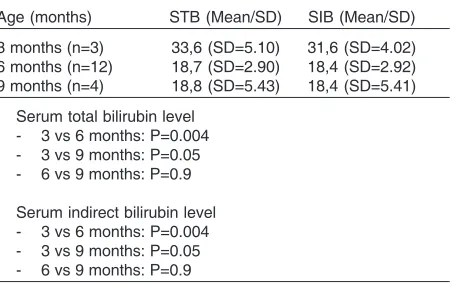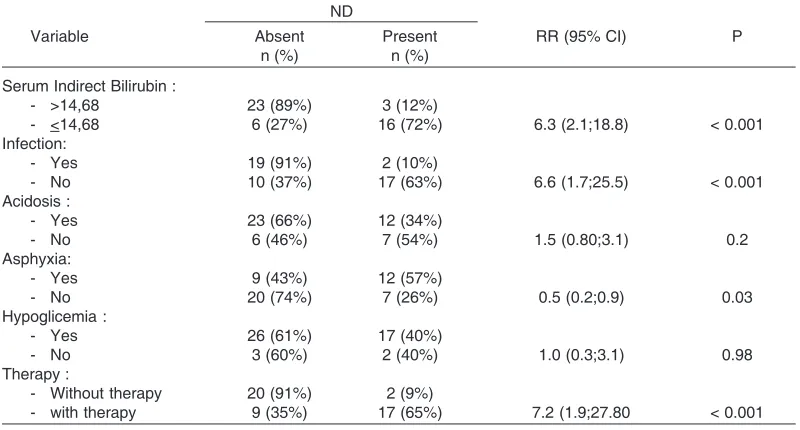Paediatrica Indonesiana
VOLUME 48 NUMBER 1
Original Article March • 2008
From the Department of Child Health, Medical School, Diponegoro University, Semarang, Indonesia.
Reprint requests to: Baginda Hutahaean, MD, Department of Child Health, Medical School, Diponegoro University, Kariadi Hospital. Jl. Dr. Soetomo 16–18, Semarang 50231. Tel 62-24-414296. Fax 62-24-318617.
Neurodevelopmental disorder risk in babies with
history of hyperbilirubinemia
Baginda Hutahaean
,
Alifiani Hikmah Putranti, Kamilah Budhi Rahardjani
N
eurodevelopmental disorder (ND) defines as failure to attain a normal neurological function that a child must have. It is caused by brain defect which occurs early in the brain development process. The initial insult of this disorder may occur in the prenatal, perinatal, or postnatal period.1-3 One of the screening tools used to asses ND risks in infants or children aged 3-24 months is BINS (Bayley Infant Neurodevelopmental Screener) score. The accuracy of BINS score assessment on each group is 75-86%.4-6 The incidence of ND cases is increasing due to the impact of improvements in neonatal care and the development in new diagnostic tools. There were approximately 20-30% cases of neuro-developmental disorder in Department of Child Health.1 One of the causes of ND that is commonly found in perinatal period is hyperbilirubinemia,4,5 defined as serum total bilirubin level (STB) >5 mg/dL (86 ìmol/L).6 Hyperbilirubinemia can cause brain “intoxication” which results in permanent neuronABSTRACT
Background Neurodevelopmental disorder (ND) is defined as failure to attain normal neurological function. Indirect bilirubin has essential role because its neurotoxic properties. Neonates with hyperbilirubinemia carry the risk to develop ND.
Objective To determine the association between neonatal indirect hyperbilirubinemia and the risk of ND.
Methods Neonates with indirect serum bilirubin (SIB) level >10 mg/dL, admitted in the period of October 2004-August 2005, were included in this study. They were followed-up and screened using Bayley Infant Neurodevelopmental Screener (BINS) at three, six and nine months. Mann-Whitney test was used to test the hypothesis.
Results Forty-eight neonates were included in the study. Mean SIB level of subjects with ND risk was 20.5 mg/dL (SD=6.06; p<0.001). Mean SIB level of subjects who developed ND at three, six and nine months was 31.6 mg/dL (SD=4.02), 18.4 mg/dL (SD=2.92) and 18.4 mg/dL (SD=5.41), respectively. There was statistically significant correlation between SIB level and ND risk (R=+0.64; P<0.001). There was also statistically significant correlation between SIB level and the onset of ND (R=-0.63; P< 0.001).
Conclusion There is a correlation between neonatal SIB level and the risk of ND in babies. [Paediatr Indones 2008;48:93-98].
damage. In this regard, the role of indirect bilirubin is essential because its neurotoxic properties. Indirect
bilirubin, in in-vitro and in-vivo studies, has been shown
to cross blood brain barrier by diffusion in high
concentration.7-9 In general, a neonate is considered
“impaired” when serum indirect bilirubin (SIB) level
>10 mg/dL.9 A neonate with hyperbilirubinemia leads
to the risk of early neonatal death or survived with a
sequel namely ND in the future.4-6
Recently some reports pointed out that hyperbilirubinemia in term babies has the potential
to cause ND.10,11 For this reason, this study was carried
out to determine the correlation between neonatal indirect hyperbilirubinemia and the risk of ND.
Methods
This prospective cohort study examined neonates with indirect hyperbilirubinemia who were admitted to the Special Care (Level II) in Dr. Kariadi Hospital, Semarang, in October 2004 to August 2005. The inclusion criteria were term babies, born spontaneously with birth weight > 2500 g, and had indirect serum bilirubin level >10 mg/dl, and the parents gave informed consent to participate. We excluded babies with history of diseases which could impair neuro-logical functions (meningitis, encephalitis, cerebral palsy), those who suffered from severe asphyxia at birth, and those with Down syndrome and/or other congenital abnormalities. The subjects were chosen by consecutive sampling method.
After selecting the neonates, clinical and laboratory examination (especially higher SIB level) were done during nursing care. After full recovery, subjects subsequently underwent screening test with Bayley Infant
Neurodevelopmental Screener (BINS) at the age of three, six and nine months to detect the risk of ND.
We presented data in frequency distribution and percentage, or with standard deviations. We performed Mann Whitney test to compare the SIB levels of subjects with and without ND risk. Level of significance was set at P < 0.05 with 95% confidence interval.
Results
Characteristics of study subjects
Forty-eight neonates were included in this study with mean age of 3.9 (SD=1.12) days. The characteristics
of study subjects were shown in Table 1.
Infection was defined based on bacteria found in culture of body specimens. The treatments for hyperbilirubinaemia were as follows: 18 (38%) subjects received phototherapy, 8 (17%) received photo-therapy and exchange transfusion, and 22 (46%) received no therapy. For the purpose of further data analyses, the subjects were categorized as receiving phototherapy with or without exchange transfusion (with therapy) which consisted of 26 subjects (54%) and subjects without phototherapy or exchange transfusion (without therapy) which consisted of 22
subjects (46%). (Table 2)
Neurological development measurement
The results of neonatal neurodevelopmental testing by BINS until 9 months of age showed that 29 (60%) subjects had no risk for ND (low BINS score), and 19 (40%) subjects had moderate ND risk (moderate BINS score). From these 19 subjects, three had their ND risk detected at three months, 12 subjects at six months, and four subjects at nine months.
Kaplan Meier test revealed that the mean occurrence of ND risk in subjects with history of neonatal hyperbilirubinemia was at 8 months.
Table 2. Neonatal bilirubin levels of subjects
Variables Mean (SD) Minimum Maximum
STB (mg/dL) 16.7 (5.87) 10.21 38.00 SIB (mg/dL) 16.1 (5.66) 10.11 35.50
Table 1. Characteristics of study subjects
Variables n (%)
Sex
- boys 26 (54%)
- girls 22 (46%)
Infection 27 (56%)
Asphyxia (mild and moderate) 27 (56%)
Hypoglycemia 5 (10%)
Acidosis 13 (27%)
Therapy
- without therapy 22 (46%)
Plasma bilirubin level and eurodevelopmental
disorder (ND)
The levels of STB and SIB in subjects with and without ND are presented in Table 3.
Results of BINS score assessments were categori-zed into three different subgroups i.e., low, moderate, and high risk groups. If subjects were defined to have high risk, meticulous investigations were performed to find any manifestations of ND. Otherwise, if subjects were classified to have moderate risk, examination then repeated one month afterwards. But if subjects were only having low risk, no ND was discovered.
Table 3 shows that the neonatal STB level of subjects with ND risk (21.1 mg/dl [SD=6.64]) is significantly higher than subjects without ND risk [13.8 mg/dL (SD=2.76)].
The same findings were also found for the neonatal SIB level, where subjects with ND risk had significantly higher level (20.5 mg/dl [SD=6.06]) than subjects without ND risk (13.2 mg/dl [SD=2.90]). Table 3 showed that either STB or SIB on subjects who was exposed to risks in developing ND was >20 mg/dl, and was significantly higher than subjects without risk of developing ND.
Correlation test revealed moderate correlation between neonatal STB level and ND risk (r = +0.62;
P<0.001). Moderate correlation was also found between neonatal SIB level and ND risk (r = +0.64; P<0.001), showing that the higher STB or SIB level, the higher risk for developing ND in the future.
The comparison of neonatal STB and SIB level based on the occurrence of ND is shown in Table 4.
The same observation was also found in SIB level, where subjects with earlier occurrence of ND risk (three months old) have significantly higher SIB level than subjects with later occurrence of ND risk (six months old; P=0.004 or nine months old; P=0.05). There was also no statistically significant
difference between neonatal SIB level of subjects who developed ND risk at six months and nine months old (P=0.9). The comparison of neonatal STB and SIB levels based on the development of ND risk is also shown in Figure 1.
Spearman correlation test showed moderate correlation between STB level and the onset of ND (correlation coefficient -0.63; P<0.001). The same correlation was also found for SIB level (correlation coefficient –0,63 ; P<0,001). This means that the higher the STB/ SIB level, the earlier will be the onset of ND.
Table 5 shows variables such as SIB >14.68 mg/ dl, infection, and subjects who was not given therapy for hyperbilirubinemia were all risk factors for developing ND in infants. Conversely, asphyxia is protective factor for ND. Nevertheless, from subsequent analysis subjects suffered from asphyxia tend to have SIB lower than subjects who never had history of asphyxia.
Discussion
From the 48 subjects in this study, the male to female ratio was 1.18:1. Earlier studies show that the sex proportion of subjects with hyperbilirubinemia varies;
Table 4. Comparison of STB and SIB level based on the occurrence of ND
Age (months) STB (Mean/SD) SIB (Mean/SD)
3 months (n=3) 33,6 (SD=5.10) 31,6 (SD=4.02) 6 months (n=12) 18,7 (SD=2.90) 18,4 (SD=2.92) 9 months (n=4) 18,8 (SD=5.43) 18,4 (SD=5.41)
Serum total bilirubin level - 3 vs 6 months: P=0.004 - 3 vs 9 months: P=0.05 - 6 vs 9 months: P=0.9
Serum indirect bilirubin level - 3 vs 6 months: P=0.004 - 3 vs 9 months: P=0.05 - 6 vs 9 months: P=0.9
Table 3. The association of neonatal hyperbilirubinemia and ND risk
Neurodevelopmental disorder risk p*
Variables Mild Moderate and Severe
Mean SD Mean SD
Total bilirubin 13.8 (2.76) 21.1 (6.64) < 0.001
Indirect bilirubin 13.2 (2.90) 20.5 (6.06) < 0.001
in general sex has no influence on the occurrence of hyperbilirubinemia or ND.12
The mean age of the subjects when hyperbili-rubinemia developed was 3.9 days. Porter reported that 60% of term neonates will have neonatal jaundice within the first week of life, which has the potential to become hyperbilirubinemia. It is also reported that hyperbilirubinemia with STB level > 15 mg/dl mostly
occur at 25-48 hours, STB > 18 mg/dl at 49-72 hours, and STB > 20 mg/dl at > 72 hours of age.6 In this
study, the onset of highest hyperbilirubinemia cannot be determined precisely. This is because the assumption of peak level was based on subjective Kramer method, before the examination of serum bilirubin level. Spearman correlation test, showed that higher STB/ SIB level will cause earlier onset of ND.
Table 5. Risk factors among neonates with risks of developing ND in infants
ND
Variable Absent Present RR (95% CI) P
n (%) n (%)
Serum Indirect Bilirubin :
- >14,68 23 (89%) 3 (12%)
- <14,68 6 (27%) 16 (72%) 6.3 (2.1;18.8) < 0.001
Infection:
- Yes 19 (91%) 2 (10%)
- No 10 (37%) 17 (63%) 6.6 (1.7;25.5) < 0.001
Acidosis :
- Yes 23 (66%) 12 (34%)
- No 6 (46%) 7 (54%) 1.5 (0.80;3.1) 0.2
Asphyxia:
- Yes 9 (43%) 12 (57%)
- No 20 (74%) 7 (26%) 0.5 (0.2;0.9) 0.03
Hypoglicemia :
- Yes 26 (61%) 17 (40%)
- No 3 (60%) 2 (40%) 1.0 (0.3;3.1) 0.98
Therapy :
- Without therapy 20 (91%) 2 (9%)
- with therapy 9 (35%) 17 (65%) 7.2 (1.9;27.80 < 0.001
Figure 1. Comparison of neonatal STB and SIB level based on the onset of ND
T
o
ta
l
Bi
liru
b
in
l
e
ve
l
(mg
/d
l)
In
d
ire
ct
Bi
liru
b
in
l
e
ve
l
(mg
/d
l)
B A
The onset of neurodevelopmentalal disorder (months)
The onset of neurodevelopmentalal disorder (months) 0.00
3 6 9
3 6 9
50.00
40.00
30.00
20.00
10.00 50.00
40.00
30.00
20.00
10.00
In this study, we found 40% subjects with ND risk, and 60% subjects without ND risk. The mean STB level of subjects with ND risk was 21.1 mg/dl, and their mean SIB level was 20.5 mg/dL. The mean onset of ND was eight months. Study by Yilmaz reported that subjects aged 10-72 months with history of neonatal hyperbilirubinemia (peak STB level < 20 mg/dl) did not show neurological abnormalities. However, 9.3% subjects with peak BTS level 20-23.9 mg/dL developed sight disconjugation, and subjects with peak BTS level > 24 mg/dl developed neuro-logical disorders.13 Newman and Klebanoff found
significant correlation between neonatal BTS level > 20 mg/dl and abnormal neurological findings, but they didn’t find significant correlation with abnormal neurological findings at 7 years.14 Another study on
the population from the Collaborative Perinatal Project concludes that there are no consistent events which support neurological abnormalities in children with history of neonatal hyperbilirubinemia > 20 mg/ dl on follow up at seven years old.12
In several studies on the correlations of hyper-bilirubinemia and ND, the age at the onset of ND could be in the range of four months to 14 years. Vohr and Paludetto also confirmed this correlation during neonatal period by using the Brazelton Neonatal Behavioral Assessment Scale (BNBAS).15,16
This study also reports the risk factors for disruption of blood brain barrier, including infection (56%), asphyxia (56%), acidosis (27%) and hypo-glycemia (10%). One of the functions of blood brain barrier is to regulate the influx of bilirubin into the brain. Free indirect bilirubin (FIB) has the ability to penetrate intact blood brain barier and then infiltrate the membrane cell of the neuron. Assessment of FIB serum concentration still can not be done in most of large hospitals in Indonesia. This partially explains why not all neonates with hyperbiluribunemia will develop ND, and ND can also develop in subjects with “low” hyperbilirubinemia concentration.3,7,17,18
In addition, there were 54% subjects who received phototherapy with or without exchange transfusion. Phototherapy and exchange transfusion are essential methods to prevent the occurrence or worsening of neurodevelopmental disorder (ND).
Asphyxia, particularly severe asphyxia, results in neuron injury due to brain ischemia. Acidosis caused by hypoxia results in deficit of oxygen supply
which subsequently generates anaerobe glycolysis, diminishes ATP and increases lactate production. Severe hypoglycaemia in neonates reduces brain electrical activity, then destructs neuron membrane, escalates glutamate production, consequently causes necrosis of the neuron.19,20
Up until now, there are no clear cut criteria on what level of bilirubin will cause ND. This question cannot be answered simply by numbers, because serum bilirubin level is only a part of many risk factors for the development of ND. However, based on previous studies, in general we can conclude that mean serum total bilirubin level > 20 mg/dL has the potential to cause ND, although STB level < 20 mg/dl can also cause ND, especially if accompanied with risk factors. Therefore, every baby must be individually evaluated based on their bilirubin level and the presence of risk factor(s).10
Limitations of the present study is that we could not determine the highest value of hyperbilirubinemia precisely. This is due to the determination of the utmost point of bilirubin serum was estimated by Kramer method which is a subjective examination before we measured the actual value of serum bilirubin. In conclusion, our study the mean STB and SIB levels in subjects with ND risk are significantly higher than in subjects without ND risk. There is moderate correlation between neonatal STB and SIB level with the risk of ND, significant correlation between neo-natal STB/SIB level and the onset of ND. Neoneo-natal infection, indirect serum bilirubin concentration >14.68 mg/dl, and no hyperbilirubinemia therapy were all factors that lead infants suffer from hyperbi-lirubinemia to develop ND.
References
1. Saharso D. Gangguan perkembangan neurologis. In: Firmansyah A, Sastroasmoro S, Trihono PP, editors. Naskah lengkap KONIKA XI. Jakarta: IDAI Pusat; 1999. p. 571-88. 2. Njiokiktjien C, Panggabean R, Hartono B. Masalah-masalah dalam perkembangan psikomotor. Semarang: Wonodri Offset Ltd; 2003. p. 1-55.


